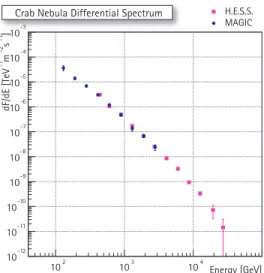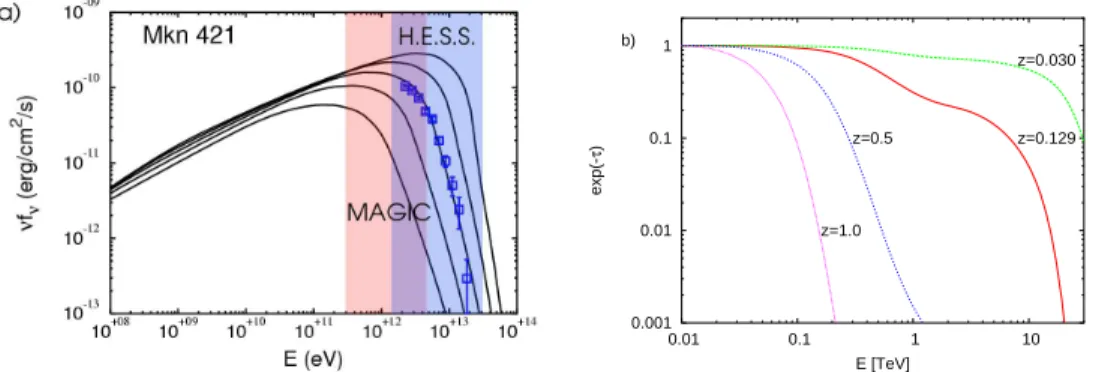29th International Cosmic Ray Conference Pune (2005) 00, 101–106
Concept of a Global Network of Cherenkov Telescopes and first joint observations with H.E.S.S. and MAGIC
D. Mazin
a, F. Goebel
a, D. Horns
b, G. Rowell
, R.M. Wagner
a, S. Wagner
dfor the MAGIC
eand H.E.S.S.
fCollaborations
(a) Max-Planck-Institut f¨ur Physik, F¨ohringer Ring 6, D-80805 M¨unchen, Germany (b) Institut f¨ur Astronomie und Astrophysik, Universit¨at T¨ubingen, D-72076, Germany (c) Max-Planck-Institut f¨ur Kernphysik, D-69117 Heidelberg, Germany
(d) Landessternwarte Heidelberg, D-69117 Heidelberg, Germany (e) http://wwwmagic.mppmu.mpg.de/ , (f) http://www.mpi-hd.mpg.de/hess/
Presenter: D. Mazin (mazin@mppmu.mpg.de), ger-mazin-D-abs3-og23-poster
New generation Cherenkov telescopes cover a wide range of longitudes (137ÆE to 110ÆW) allowing continu- ous observations to follow transient sources. Given the close match in longitude of the MAGIC (17.9ÆW) and H.E.S.S. (16ÆE) sites, simultaneous observations at greatly differing zenith angles are also feasible. The mea- surable energy range can thus be extended beyond what is accessible to individual instruments. The planning and coordination of world-wide observations is challenging and requires close interaction between the differ- ent collaborations. The potential of Global Network of Cherenkov Telescopes (GNCT) campaigns for blazar physics and studies of the energy dependent absorption of very high energy (VHE)-rays on the extragalactic background light are discussed. Also, first results from a joint H.E.S.S. and MAGIC observation of Mkn 421 in 2004 are presented.
1. Introduction
The new generation of Imaging Air Cherenkov telescopes offers a unique opportunity to perform joint obser- vation campaigns. Due to their similar longitude the fully operational H.E.S.S. and MAGIC telescopes allow simultaneous observations, which will greatly improve their capability to study variable VHE-ray sources and extend the energy range covered.
The High Energy Stereoscopic System (H.E.S.S. ) is located in Namibia (23Æ160S, 16Æ300E). It consists of 4 identical 13 m diameter Cherenkov telescopes with 107 m2 tessellated and automatically adjustable glass mirror facets [1]. The energy threshold achieved for observations close to the zenith is around 100 GeV with an angular resolution of better than 0.1Æfor individual events. For large zenith angles the threshold energy increases to 1.2 TeV at 60Æzenith.
The 17 m diameter MAGIC telescope is located on the Canary Island of La Palma (28Æ300N,17Æ530W) at an altitude of 2200 m a.s.l. MAGIC is currently a stand-alone instrument with a second telescope under construc- tion. Owing to its novel technologies and large mirror area, and its fine granulated camera with high quantum efficiency PMTs, MAGIC was designed to detect VHE-rays of energies down to 30 GeV [2]. Its sensi- tivity permits the detection of signals from Crab-like sources within a few minutes. MAGIC started regular observations in August 2004.
2. Observational prospects
The combination of similar longitude but widely different latitudes of the H.E.S.S. and MAGIC sites allows one to carry out simultaneously small and large or very large zenith angle observations for sources with dec-
2 D. Mazin et al.
linationjÆj > 20Æ like e.g. Mkn 421 (Æ = +38Æ1203200), Mkn 501 (Æ = +39Æ4503700), PKS 2155-304 (Æ= 30Æ1303200), M 87 (Æ =+12Æ2302900), and H1426+428 (Æ=42Æ4002100). Observations at low zenith angles allow measurements with a low energy threshold. For large zenith angles the Cherenkov light cone illuminates a large region on the ground. Due to the reduced photon density this results in a higher energy threshold. On the other hand the effective collection area is significantly increased which improves the sensi- tivity for-rays at high energies, where the fluxes are very low. Figure 1 illustrates the observational situation between two facilities located as MAGIC and H.E.S.S.
Observatories at similar latitude but different longitude (e.g. MAGIC in La Palma and VERITAS in Arizona or H.E.S.S. in Namibia and CANGAROO III in Australia) allow a different observation strategy. Follow-up observations of variable sources effectively allow one to overcome the long gaps in observation time of ground based Cherenkov detectors during day time.
Figure 1. For two observatories at different latitudes, the showers will be observed under different inclination angles. Observations at high inclination angles result in a large collection area but also a high energy threshold.
Energy [GeV]
102 103 104
]-1 s-2 m-1 dF/dE [TeV
10-12 10-11 10-10 10-9 10-8 10-7 10-6 10-5 10-4 10]
H.E.S.S.
MAGIC Crab Nebula Differential Spectrum
Figure 2. Combined energy spectrum from the Crab nebula taken around culmination. The large overlap of the energy spectra allows a good cross-calibration.
3. Physics goals
GeV-TeV spectra cover 3 decades in energy
For simultaneous observations of bright sources (F FCrab), it is possible to obtain a differential energy spectrum between 30 GeV and 30 TeV within a few hours of observation. In Figure 2, an energy spectrum of the Crab Nebula combining MAGIC and H.E.S.S. data is shown. The H.E.S.S. results have been obtained using 10 h of data from 2003/2004 at mean zenith angle of 45Æ. For the MAGIC measurements 2 hours of data taken in 2004 at a mean zenith angle of 15Æhave been used. The Crab Nebula is a standard candle for GeV-TeV emitting a constant flux of-rays. Therefore, data taken at different times can be compared. Since the Crab Nebula has a declination of 22Æ, the energy thresholds of the two telescopes, while differing by a factor of 4, still allow considerable overlap in the energy spectra. It is therefore an ideal source to cross calibrate the two instruments in the overlapping energy range. Figure 2 shows good agreement between the independent detector calibrations.
Concept of GNCT and first joint observations of H.E.S.S. and MAGIC 3
TeV blazars – catching rapid broadband variability
TeV blazars are known to exhibit strong variations in their-ray emission. The intensity may change by more than one order of magnitude and large variations on time scales down to 10 minutes have been measured.
Also the shape of the energy spectrum has been observed to change with the integral flux (see Figure 3 a for an example of the expected variation of the spectral energy distribution). A precise measurement of the energy spectra during different states of the source is essential to understand the physics of the highly relativis- tic plasma and its interaction with the ambient medium. Simultaneous measurements covering three energy decades as proposed here are an ideal tool to study the rapid broadband variabilities of TeV blazars. We expect a strong improvement in the understanding of the acceleration and cooling processes during flares of these objects. Good candidates for these studies are Mkn 421 (z =0:031) and Mkn 501 (z =0:034). They show strong flares reaching flux levels several times higher than that of the Crab Nebula.
Measuring the optical depth due to pair creation processes
-rays emitted from far distant galaxies are absorbed via pair-production by interaction with photons of the optical / near IR extragalactic background light (EBL):TeV
EBL
!e +
e .
The expected density of the EBL is a matter of debate [3, 4, 5] and difficult to measure directly [6]. The measured spectra of distant GeV-TeV sources can be used to determine (or at least to constrain) the energy density profile of the EBL. The task is rather difficult since it requires knowledge of the intrinsic spectra of the GeV-TeV-ray emitters. However, as shown in Figure 3 b for a specific red shift range, the expected optical depth () is very small ( <1) up to a few 100 GeV and then increases dramatically ( >1) beyond TeV energies. Observations covering a broad band in energy would allow simultaneous measurement of the intrinsic spectrum of the source at low energies and at high energies where the apparent spectrum is modified by absorption due to pair production processes. The best known candidate for joint observations so far is H1426+428 (z=0:129) with an intrinsically hard spectrum, so that the TeV component can still be measured.
We expect to disentangle the impact of absorption and source spectrum on the apparent spectrum.
0.001 0.01 0.1 1
0.01 0.1 1 10
exp(-τ)
E [TeV]
z=0.030
z=0.129 z=0.5
z=1.0 b)
Figure 3. a) An example for expected broad band spectral variability of Mkn 421. The energy spectrum is the time- average as measured with the H.E.S.S. telescopes at low elevations in April 2004 [7]. The curves indicate changes of the expected energy spectrum assuming a self-synchrotron Compton model with varying maximum injection energy of the electrons. b) The expected optical depth for different red shifts assuming a model calculation for the extragalactic background light [3].
Morphology of extended sources at different energies
It is becoming obvious that many Galactic sources are extended, but this extension may vary with energy [8].
For the interpretation of the acceleration mechanism knowledge of the energy dependent morphology for these objects is necessary. Coordinated (not necessarily simultaneous) effort will be considered to achieve exposure at different energy ranges more efficiently by combining low and high elevation data.
4 D. Mazin et al.
4. First results from a joint H.E.S.S. and MAGIC observation
Triggered by an increased activity observed in the X-ray band and by the VERITAS collaboration (H. Krawczyn- ski, priv. comm.) on December 14, 2004 the H.E.S.S. and MAGIC collaborations performed joint observations of Mkn 421. Due to weather conditions common observations were performed only during two nights (Decem- ber 18 and 19). Moreover, due to observational constrains (such as zenith angle and dark time), the common observational window was only open for 30 minutes on each night. The joint data sample of Mkn 421 encom- passes:
1. H.E.S.S. : 1h, zenith angle range = 65-67Æ, good weather conditions 2. MAGIC : 1h, zenith angle range = 47-54Æ, good weather conditions.
In addition to these joint observations more data on the Mkn 421 flare were taken by the two experiments without a time overlap. The H.E.S.S. measurements contain 0.5 h at mean zenith angle of 67Æon December 16; the MAGIC data contain 2.5 h at mean zenith angle of 15Æon December 18 and 19. The results of the analysis of the data [9, 10] show clear detections in the simultaneous data set (6 - 10) and a reasonable number of photons collected in the different energy bands. The results are encouraging given the comparably low flux state of the source, the short simultaneous observation time, and the non-optimal zenith angles observed. The energy spectrum and a light curve of the common data set are in preparation.
5. Concept of a Global Network of Cherenkov Telescopes
With the installation of the four major Cherenkov telescope facilities (CANGAROO III, H.E.S.S. , MAGIC, VERITAS), global networking of these telescope facilities is becoming feasible. Different physics questions could motivate different type of observations (at different longitudes and/or latitudes). Currently the MAGIC and the H.E.S.S. collaborations are organizing a well defined joint observation strategy including fast mutual information exchange on target of opportunity sources.
Acknowledgements
The authors acknowledge the support and help of both collaborations and the respective teams, funding agen- cies, and the excellent working conditions on both sites.
References
[1] Hofmann, W. et al., these Proceedings.
[2] Mirzoyan, R. et al., these Proceedings.
[3] Primack, J. et al., AIP Conf. Proc. 745, 23 (2005).
[4] Costamante, L. et al. New Astron. Rev. 48, 497 (2004).
[5] Dwek, E. & Krennrich, F. Astrophys. J. 618, 657 (2005).
[6] Hauser, M.G. & Dwek, E. ARA&A, 39, 249 (2001), (astro-ph/0105539).
[7] Aharonian, F. et al., A&A 437, 95 (2005) [8] Aharonian, F. et al., Science 307, 1938 (2005).
[9] Mazin, D. et al., these Proceedings.
[10] Horns, D. et al., these Proceedings.

